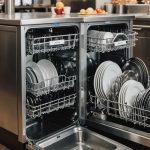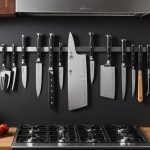Understanding Energy Consumption in Kitchens
Kitchens are a hub of energy use in the home, with appliances running both day and night. According to recent statistics, a significant portion of a household’s electricity bills can be traced back to the kitchen. Energy efficiency is paramount in ensuring lower utility costs and a reduced ecological footprint.
Several factors drive high kitchen energy use, especially during peak hours. Key contributors include the frequent use of ovens and refrigerators, as well as smaller appliances like microwaves and dishwashers. These devices, often used simultaneously, can lead to surges in energy consumption.
Topic to read : Designing a dynamic kitchen: tailoring culinary spaces for carnivores and herbivores alike
The push for energy efficiency in modern kitchens extends beyond merely cutting costs. Smart kitchen designs are evolving, incorporating technology to monitor and manage electricity usage. Sensors and programmable systems help optimise appliance operation, ensuring energy is used judiciously.
By understanding and implementing energy-efficient practices and smart designs, homeowners can significantly reduce the impact of their kitchen’s energy use. This not only benefits household budgets but also supports wider environmental goals by shrinking energy demand during peak times.
Additional reading : Elevate your kitchen makeover: innovative and energy-saving lighting solutions for a brighter space
Smart Appliances for Energy Savings
Transforming your home into an energy-efficient haven is easier with the help of smart appliances. These smart kitchen devices are designed not only to make your life more convenient but also to reduce energy consumption significantly.
Energy-efficient cooking appliances
Cooking with energy-efficient appliances can lead to substantial savings on your energy bill. Induction cooktops, for example, use electromagnetism to heat cookware directly, which is quicker and consumes less electricity than traditional stoves. Additionally, smart ovens that optimize cooking times based on the dish being prepared can help conserve energy without compromising on meal quality.
Smart refrigeration solutions
Refrigerators are one of the most essential kitchen devices, often accounting for a significant portion of household energy use. Modern smart fridges utilize sensors and smart tech to maintain optimal temperatures and minimize energy usage. Features like alerts for open doors and energy-saving modes further enhance energy efficiency.
Effective use of microwaves and ovens
Maximize your savings by choosing microwaves and ovens with automation features, which adjust power settings and cooking durations automatically. This not only saves energy but also ensures perfectly cooked meals with less effort. Comparing traditional vs. smart appliance usage highlights the clear advantage of upgrading to these advanced devices.
Optimizing Kitchen Layout for Efficiency
In creating an efficient kitchen layout, understanding fundamental design principles is key. A well-designed kitchen optimizes both workflow and energy usage, ensuring that tasks are completed seamlessly.
Zoning your kitchen is one critical principle. By assigning specific areas for tasks such as food preparation, cooking, and cleaning, you can streamline activities to minimize unnecessary movements. This approach not only saves time but also reduces energy consumption, as everything you need is within a convenient arm’s reach.
Strategic appliance placement also plays a vital role in kitchen design optimization. Consider the classic “work triangle”—an imaginary line connecting the sink, stove, and refrigerator. Ideally, these core areas should form an unobstructed and efficiently-spaced triangle to promote a natural flow. Appliances should be positioned to cater to your everyday needs without blocking paths or creating congestion.
Moreover, incorporating energy-saving appliances such as induction cooktops or energy-efficient dishwashers can further support an energy-efficient workflow. These small adjustments in your kitchen design will lead to significant improvements in efficiency and functionality, making daily culinary tasks more enjoyable and less of a chore.
Behavioral Changes to Reduce Energy Usage
Changing your energy-saving habits in the kitchen can lead to significant reductions in your energy consumption. One effective way to manage this is by adopting kitchen energy management techniques. These incorporate small yet impactful changes in your daily routine.
Start with simple habits like unplugging appliances when not in use. This action alone can cut down energy wastage. Additionally, focus on using appliances, like dishwashers and ovens, efficiently. Try to run full loads and avoid excessive preheating times.
Time management in meal preparation is crucial, too. Plan dishes that maximize the use of your oven or stove simultaneously. Matching your cooking schedule with off-peak energy hours further optimizes energy use. Peak hours typically cost more; thus, cooking during off-peak hours saves money and energy.
Incorporate these strategies seamlessly into your daily activities to form a habit that promotes efficient energy use. By consciously aligning your cooking efforts with energy-efficient practices, you’ll notice marked improvements in both energy bills and environmental impacts. Over time, these adjustments will become second nature, helping ensure a more sustainable lifestyle.
Case Studies: Successful Smart Kitchen Transformations
Transforming your kitchen can result in impressive energy savings. Here are some kitchen renovation examples that showcase significant improvements.
High-efficiency kitchen remodel
In one case, a dated kitchen underwent a comprehensive remodel focusing on energy-efficient appliances and LED lighting. The transition resulted in significant energy savings, reducing the overall electricity bill by 30%. Swapping outdated appliances for those with higher energy star ratings was key to this efficiency.
Innovative designs reducing energy costs
Another example involved incorporating innovative design elements like natural light utilization and smart thermostats. These kitchens used reflective surfaces to enhance natural light, cutting down on the need for artificial lighting. Smart thermostats also played a vital role by optimizing heating and cooling according to usage patterns, contributing to further energy reductions.
Lessons learned from successful renovations
These renovations highlight several lessons for anyone interested in saving energy during a kitchen remodel:
- Prioritize energy-efficient appliances.
- Consider design changes that maximize natural light and air flow.
- Install smart technology for better control over energy consumption.
By analyzing the impact of these changes, homeowners not only achieved energy efficiency but also enjoyed a modern, aesthetically pleasing kitchen.
Utilizing Technology for Monitoring Energy Usage
Energy monitoring technology is transforming how we manage our homes, especially in the kitchen. With the advent of smart kitchen systems, homeowners can now easily track and manage their energy consumption with precision. These systems often comprise smart meters and intelligent appliances that provide real-time data, helping users identify energy-heavy devices and optimize their usage.
One of the major benefits of using energy monitors in the kitchen is the potential for reducing electricity bills. By identifying which appliances use the most power, homeowners can make informed decisions about how to use them more efficiently. For example, if a refrigerator is consuming more energy than usual, it may be a sign that maintenance is needed or that upgrading to a more efficient model could be beneficial.
Integrating various devices into a comprehensive energy management system enhances control and visibility over household energy use. These integrated systems not only report energy usage but also offer recommendations to optimize consumption patterns. Through smartphone apps and other interfaces, users gain a deeper understanding of their energy footprint, empowering them to embrace more sustainable cooking and overall energy habits.
Government Programs and Incentives for Energy Efficiency
Investing in energy efficiency incentives can significantly reduce costs for kitchen renovations. Many government energy programs are designed to support homeowners in adopting efficient appliances and sustainable practices. These initiatives include tax credits and rebates that make it easier for individuals to upgrade to more energy-efficient kitchens.
Local and federal initiatives promote kitchen energy savings through various avenues. The government offers tax credits for installing energy-efficient appliances, like dishwashers and refrigerators, which are often available during dedicated periods or tax years. These credits serve as a direct reduction in the amount of taxes owed.
Rebates can also be accessed through specific government energy programs. Local utilities frequently participate in these schemes by providing financial incentives for purchasing or installing approved energy-efficient products.
Moreover, specific programs may even assist with the upfront purchase costs or offer loans for larger projects. Local incentives can vary, so homeowners are encouraged to consult their local government or utility providers to fully leverage these opportunities. The focus remains on decreasing energy consumption and making environmentally sustainable choices economically viable.











